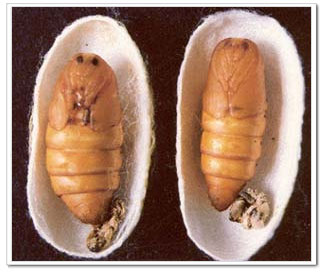Chinese Silk is almost synonymous with China and dates back to about 2640 BC. The Chinese Empress Hsi Ling Shi (venerated as the Goddess of Silk) gave her royal patronage to the silk industry. She invented the loom and applied it to the production of highly prized silk fabrics.
For some 3,000 years the secrets of sericulture were closely guarded by the Chinese. It was not until about 300 AD that a secret mission from Japan succeeded in penetrating China. The members of the mission obtained silkworms and took four Chinese girls back to Japan to teach the Japanese the art of sericulture and the uses of silk.
 According to legend, the silk industry spread to India when a Chinese princess was given in marriage to an Indian prince. When she went to India, the princess carried silkworm eggs and mulberry seeds concealed in her headdress. From India the silk industry spread into Persia and Central Asia, before slowly filtering into the Mediterranean countries.
According to legend, the silk industry spread to India when a Chinese princess was given in marriage to an Indian prince. When she went to India, the princess carried silkworm eggs and mulberry seeds concealed in her headdress. From India the silk industry spread into Persia and Central Asia, before slowly filtering into the Mediterranean countries.
Beginning early in the 2nd century BC, caravans traveled the Silk Road, a 4,000-mile (6,400-kilometer) trade route linking China with the West. The route began in Xi'an in China and wound its way to the countries along the eastern Mediterranean shores. From there the silk was transported to Rome.
Today, silk has been replaced in many applications by synthetic fibers, which can be produced more cheaply and are generally stronger and easier to maintain. Nevertheless, the production of silk is so small compared with the total world fiber production that the development of synthetic fibers has had little effect on the silk industry overall. Particularly in the luxury apparel market, silk still reigns supreme.

